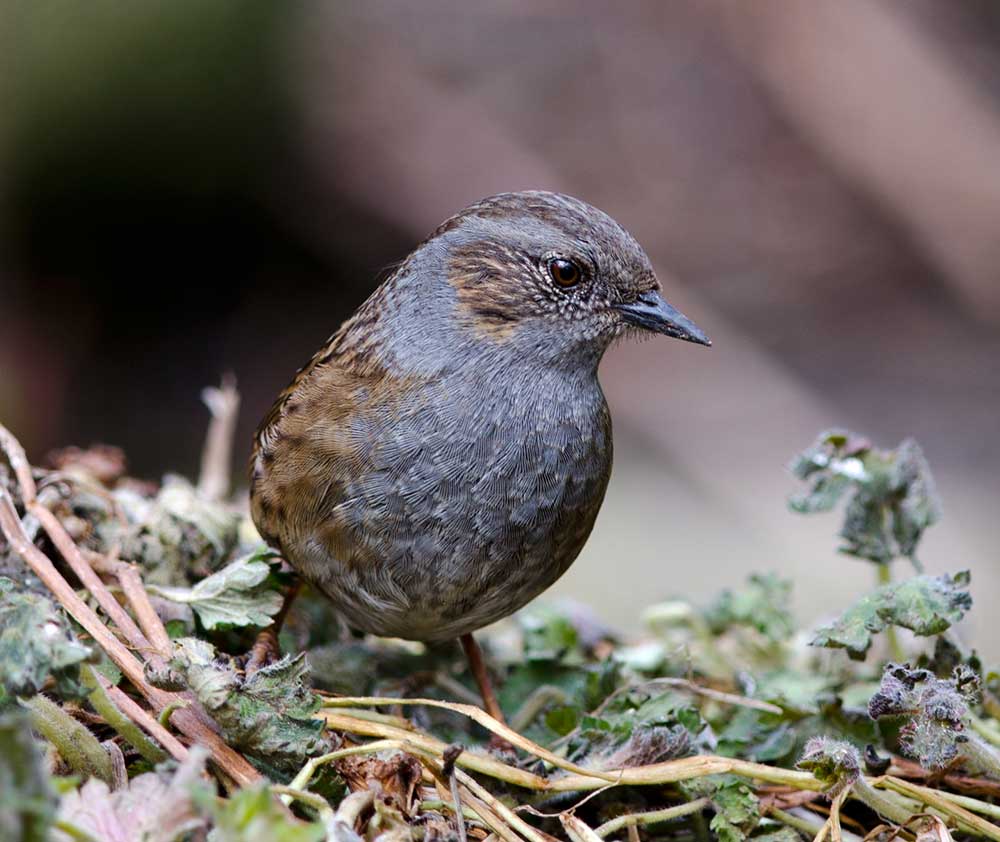Overview
The dunnock is generally a quiet inconspicuous bird, and so often goes un-noticed by many people. It is the classic “L.B.J.” or “little brown job”! A nickname for the dunnock is ‘hedge sparrow’, this gives away the bird’s habit of lurking quietly in hedgerows but it is in fact not a sparrow or related to sparrows. Dunnocks are usually seen individually, hopping on the ground with regular flicks of wings and tail or in open view when singing. Flight is light and irregular. The dunnock is common, resident all year and non-migratory in Britain and much of Europe, residing and breeding in a mixture of bushy habitats from parks, open woodland, scrub-land and heathland. It is a common bird in towns, cities and villages in western Europe. Food consists mainly of insects.
While the dunnock may seem a little boring to some people, some of their behaviour is actually quite complex and interesting, especially when it comes to breeding. Dunnocks have a colourful and varied sex life which would make any episode of Hollyoaks or Sex In The City seem tame! Both male and females may have more than one partner during the breeding season. They use a number of breeding strategies to pass on their genes to the next generation, including the ‘traditional’ one male paired with one female (known as ‘monogamy’) or… two or more males paired with one female (‘polyandry’), or…. one male paired with two or more females (‘polygny’), or….. two males paired with two females (‘polygynandry’)…… phew, it seems that anything goes if you’re a dunnock!
Description
A mainly brown robin-sized bird. Has brown and black streaked upperparts a little similar to that of a house sparrow. However a dunnock has finer black or dark streaks which cover much of the plumage, extending onto the head, throat and the paler greyish underparts. Although they can initially appear rather dull dark brown birds, if seen closer you will see the attractive rich streaked plumage. Also possible to see at close range is the bird’s striking red-orange eyes, but it is unusual to get close enough to see this detail! If unsure about the identity of a nondescript brown bird look for the characteristic bluish grey head (‘crown’) throat and upper breast, which should separate adult dunnocks from any other bird in your garden. Legs are reddish brown, the thin pointed bill is dark or blackish. Sexes are alike, apart from males often having more grey on the head and throat than females.
Call & Song: Song is a loud clear warbling jumble of notes of a similar pitch, often given in clear view from the top of a tree, bush or hedge. Can sound a bit similar to robin but ‘flatter’ and generally less musical, but not unpleasant to listen to. The main call or alarm-call is a somewhat high-pitched often quiet ‘tseep-tseep’, a little like the opening of a squeaky gate.
Latin name: Prunella modularis
Size: 13 – 14 ½ cm

In The Garden
Dunnocks are very common in Britain and can be seen in most gardens at some time, for example hopping on your lawn, through flower beds or under hedgerows, although they usually stay close to cover. A dunnock is a pretty unfussy eater, and with their slender pointy bills will happily scoff any titbits such as insects, spiders and small seeds – not unlike a little brown hoover in your garden, collecting the bits ‘n’ bobs other birds might have missed. They are rather good at tidying up spilt food on the ground under bird feeders. By putting out a range of food and growing various dense shrubs and plants for cover and refuge for insects, you should easily attract the humble dunnock to your garden.
Did You Know…?
- As usual the scientific species name describes the bird’s characteristics well… Prunella modularis effectively translates as “brown singing bird” (from Latin prunus = brown, and modulari = to sing).
- Alternative local and country names for the dunnock include the very evocative “Shufflewing”, “Creepie” or “Scrubber”…. or even “Dirty-dunnock” (I made that one up!).


